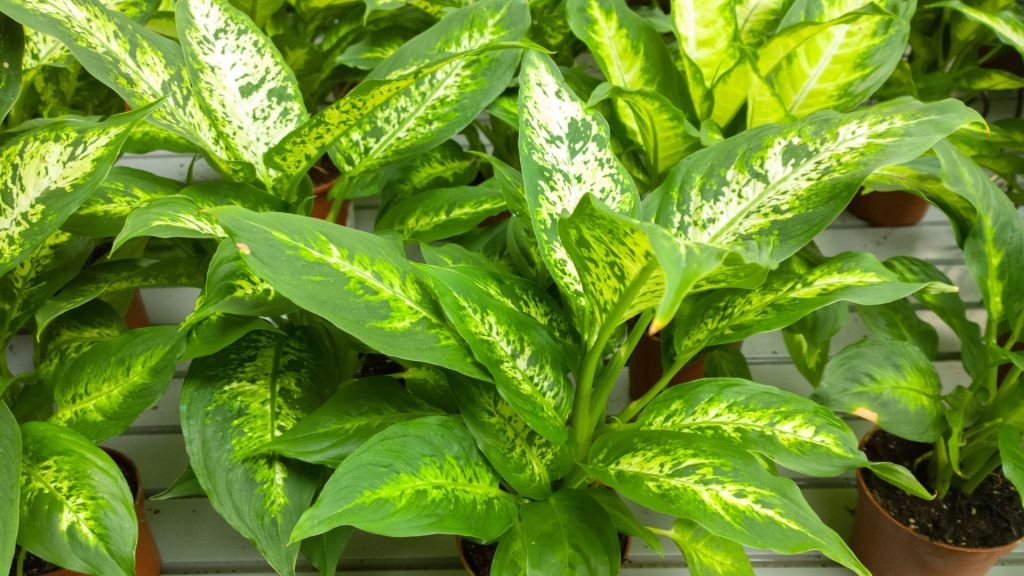There are a number of plants that belong to the dieffenbachia genus. They are gorgeous tropical perennials, and they make great houseplants. I have a dieffenbachia plant at home, and I am always stunned by its beauty. So if you are interested in growing dieffenbachia, read on to find out more information about this plant, and get all the dieffenbachia care instructions.
What is a Dieffenbachia Plant?
The dieffenbachia plant is also known as “Dumb cane”, it got this nickname because the sap of the plant is toxic, and when ingested it can cause irritation. So it is not the ideal plant to have in an environment with small children or pets.
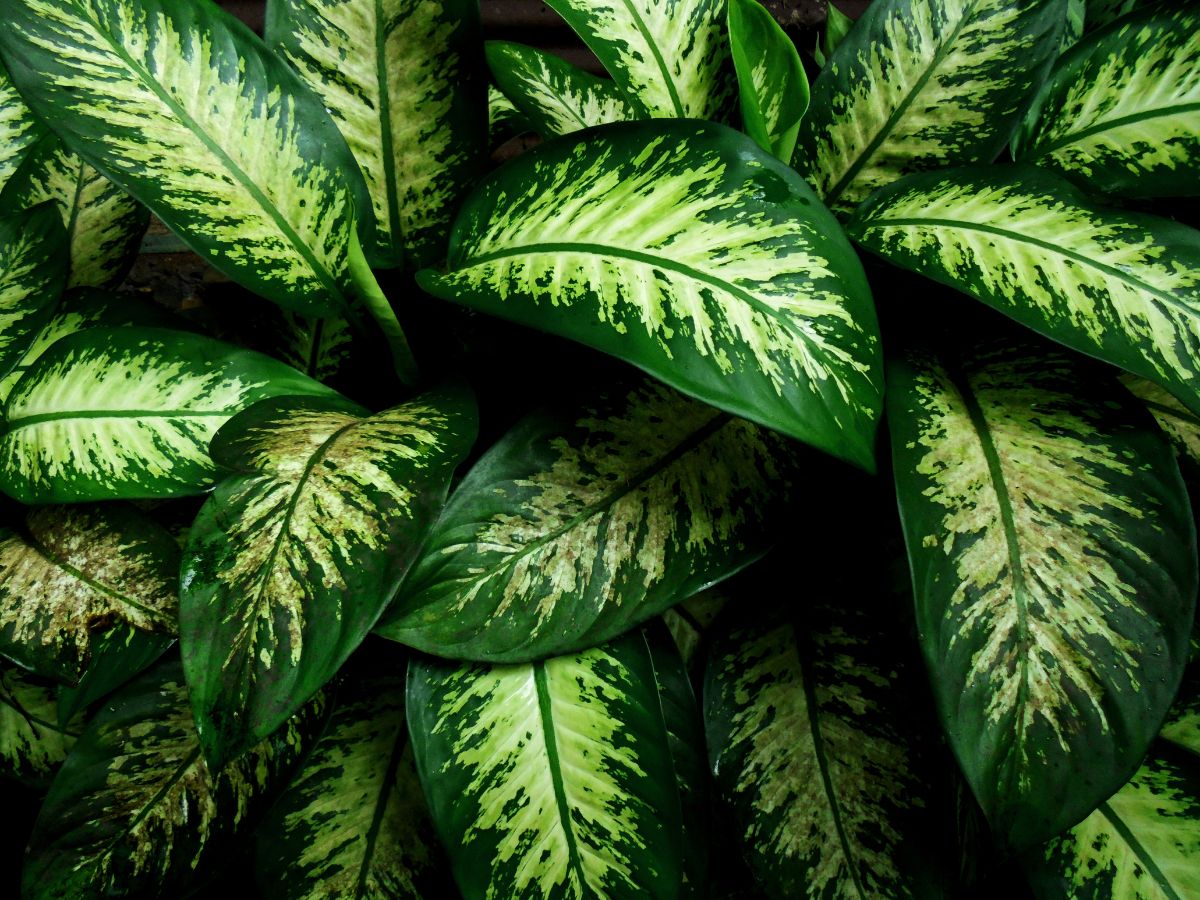
Characteristics of Dieffenbachia Plants
Physical appearance
Dieffenbachia is a tropical plant with a bushy growth habit. It is a popular houseplant because of its beautiful foliage, which is characterized by large, green leaves with yellow or white spots, stripes, or patches. The leaves of Dieffenbachia can grow up to 10 inches in length and are typically broad and oval in shape.
- Height and Spread: The height and spread of a Dieffenbachia plant can vary depending on the cultivar and growing conditions. On average, they can reach a height of 2-6 feet tall and have a spread of 1-3 feet wide.
- Leaves: The leaves of Dieffenbachia are the plant’s main attraction. They can have different shapes, sizes, textures, and colors depending on the variety. The leaves may be dark green, light green, or variegated with yellow, white, or cream. The texture of the leaves can be smooth or glossy.
- Stem: The stem of a Dieffenbachia plant is thick, woody, and upright. It is usually green in color and may be marked with a pattern of stripes or spots that match the leaves.
- Flowers: The flowers of Dieffenbachia are not particularly showy and are usually hidden by the foliage. They are small, white, and tubular in shape. The flowers are followed by berry-like fruits that are also not significant.
- Fruits: The fruits of Dieffenbachia are small, berry-like, and green in color. They are not edible and are not of particular ornamental value.
Different varieties and cultivars
Dieffenbachia is a diverse plant species, and there are many varieties and cultivars available to choose from. Here are some popular Dieffenbachia cultivars and their characteristics:
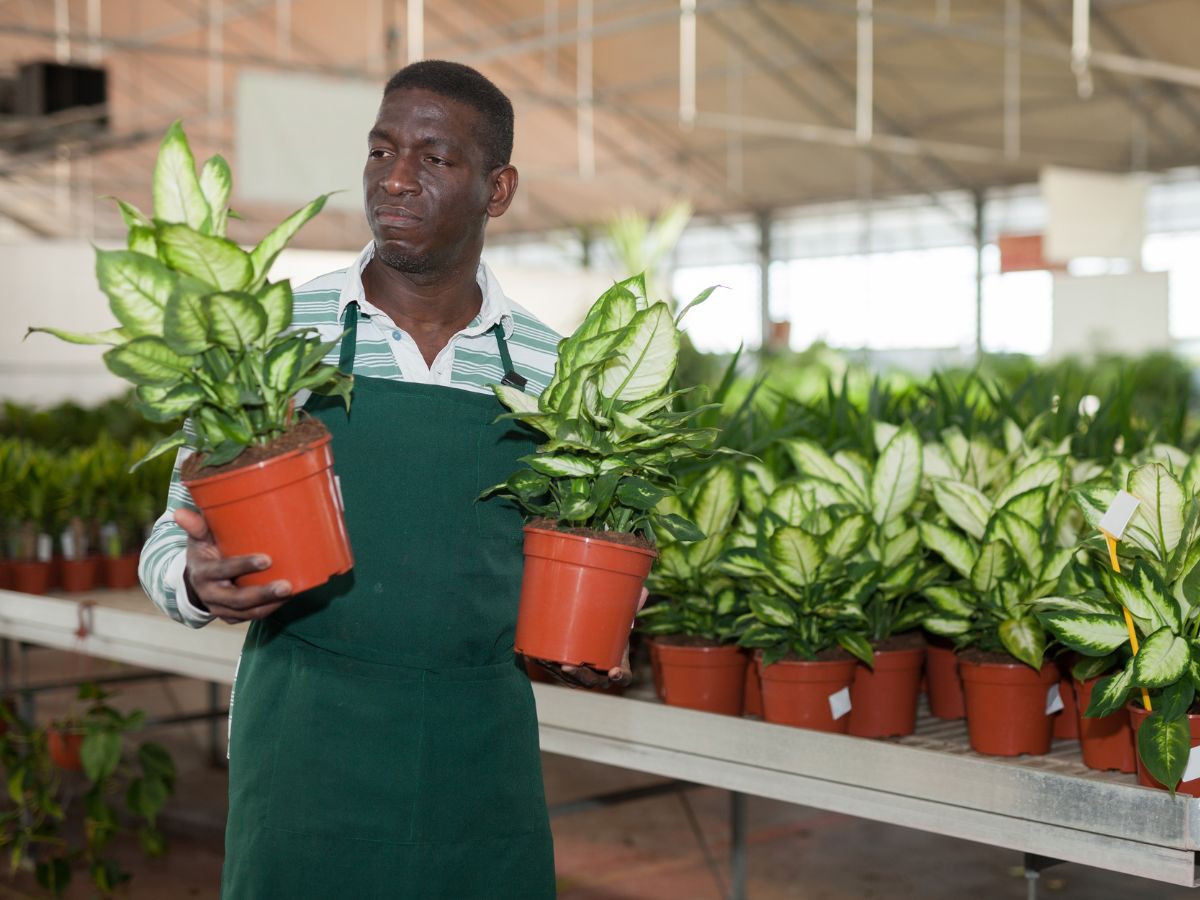
- Tropic Snow: The Tropic Snow cultivar is a popular Dieffenbachia plant known for its green and white variegated leaves. The leaves have a broad, oval shape and are marked with irregular white patches that give the plant an overall snow-like appearance.
- Camille: The Camille cultivar is another popular Dieffenbachia variety with variegated foliage. Its leaves are predominantly green with creamy white speckles that become more prominent towards the center of the leaf.
- Compacta: The Compacta cultivar is a smaller variety of Dieffenbachia that grows to about 2 feet tall. It has dense foliage and a compact growth habit, making it an excellent choice for smaller spaces.
- Exotica: The Exotica cultivar is a stunning Dieffenbachia variety with deep green leaves that are heavily marked with creamy white spots and stripes. The leaves are broader than those of other cultivars, making them stand out.
- Other varieties: There are many other varieties of Dieffenbachia available, including D. maculata, D. seguine, and D. picta. Each of these has unique physical characteristics that distinguish it from other varieties.
- Comparison: When choosing a Dieffenbachia plant, it’s essential to consider the physical appearance of each variety, as well as its care requirements. Some varieties may require more light or water than others, and some may be more susceptible to pests and diseases. By comparing the different cultivars, you can find the one that best suits your needs and preferences.
How to Care for Dieffenbachia Plants
When talking about dieffenbachia care there are a few things you need to know if you want your plant to thrive. So I will start by talking about some dieffenbachia care problems. Because it is a tropical plant, it does better in environments with high humidity, so if during the winter months it tends to get dry where you live, the pot can be placed on a wet pebbles tray, and you can spray the leaves of the plant with some water.

But, when growing dieffenbachia, the problem that is most common is excess moisture. As is true in the case of most houseplants, overwatering is one of the biggest dieffenbachia problems. So it is important that you plant your dieffenbachia in well-draining soil, and that you water it lightly, which means the soil should be maintained moist, but definitely not soggy. Before watering your plant you can check if the top 2,5 cm of soil are dry, if yes then it means you can water it.
Other dieffenbachia problems may be caused by wrong light conditions. Most of the varieties of dieffenbachia, when growing indoors, will grow best under bright, indirect sunlight.
Here are some more pieces of information you need to know to take care of the dieffenbachia house plant.
Soil
Use well-draining and aerated potting mix. In order to avoid the roots getting damaged, it is important that the drainage happens well, as I said before, they shouldn’t be left swimming in soggy soil.
Light
These plants are great indoor plants because they are able to tolerate lower light conditions. But they do enjoy some bright light, especially during the months of winter. In the growing season, these plants thrive when they have access to indirect sunlight. Because the side that is facing the direction of the light tends to be favored, it is good that once in a while you rotate your plant a little. If you notice that your dieffenbachia stopped growing, it probably means that it is not getting enough light.
Watering
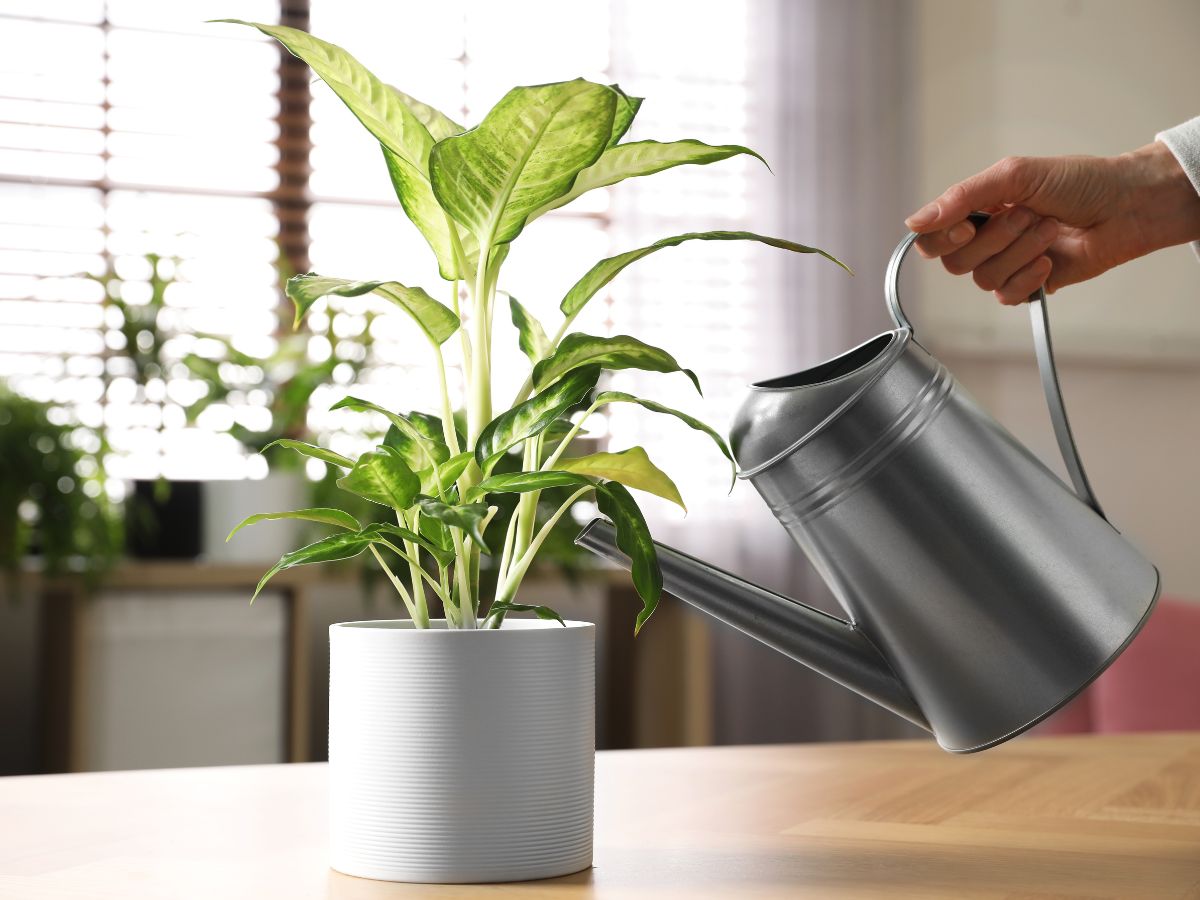
Dieffenbachia watering is quite simple once you get used to it. In the growing season, don’t let the soil dry out, it should be kept regularly moist. In the case of a big dieffenbachia twice a week watering might be needed, but remember to reduce the amount of water during the winter. Although you are aiming to keep the soil moist, it is important that you don’t overwater your plant because this can end up causing root rot. By making sure the top part of the soil is dry before giving your plant more water, you will avoid this problem.
Humidity and temperature
Dieffenbachias like warmer conditions, between 18 to 23 celsius. In the case, the temperatures drop below 15 celsius or the plant gets exposed to cold drafts, there is a good chance that it will start dropping its lower leaves.
Fertilizer
You can choose to feed your plant every month or so using a diluted, balanced fertilizer. Although there are some people that use a diluted weak fertilizer in every watering.
How to Propagate Dieffenbachia
Propagation of dieffenbachia plants can be done in three fairly easy ways:
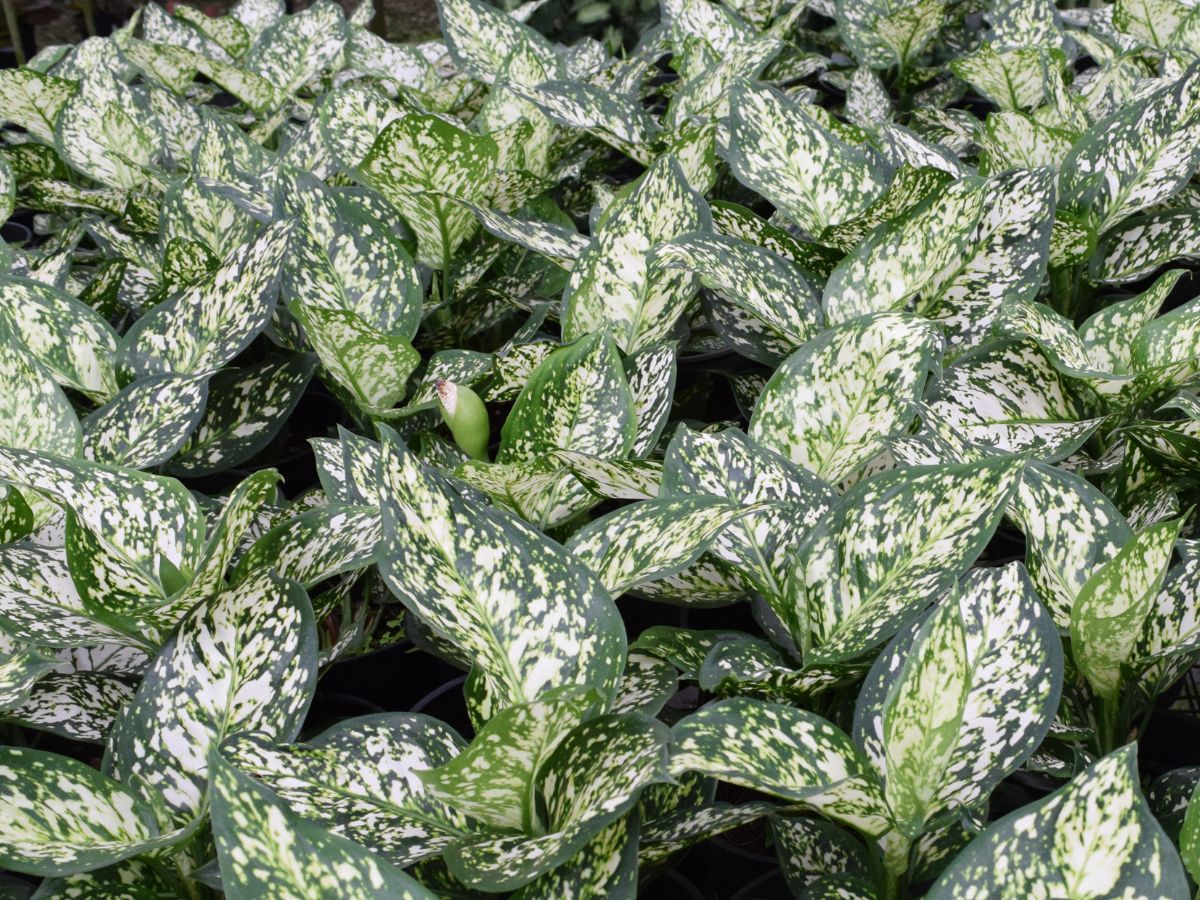
- When you re-pot your plant in the spring, you can divide the offsets (leaving them with some intact roots) and plant them in separate new pots. If you decide to use this propagation method, it is important that you are careful that the parent plant’s roots system is not damaged in the process, and try to use a tool that has been sterilized this way any spread of disease can be avoided.
- In the case of leggy, older dieffenbachias, what you can do is cut off the top of the plant and plant it into new potting soil with some rooting hormone. After a while, the stump will start sprouting new leaves. When the new leaves have started to appear, you can remove the old ones.
- You can sprout pieces of the cane. To do this you just need to lay the pieces in potting soil that is damp. After a while, the pieces will start taking roots, and later on, leaves will start sprouting.
Common Problems and Solutions
Pests
Dieffenbachia plants can be affected by a variety of pests, including spider mites, mealybugs, thrips, scale insects, and aphids. These pests can cause damage to the leaves and stem, as well as spread diseases.
To identify a pest infestation, inspect the plant for signs such as discoloration or spotting on the leaves, visible insects or webs, and sticky residue. Preventative measures include keeping the plant clean, avoiding overcrowding, and quarantining new plants to prevent introducing pests into the area.
Natural treatments for pest control include insecticidal soap, neem oil, and rubbing alcohol. Chemical treatments such as pesticides should be used as a last resort, and only if natural methods have failed.
Diseases
Dieffenbachia plants can also be affected by several diseases, including leaf spot, stem rot, and root rot. These diseases can be caused by fungal or bacterial pathogens, and can spread quickly if not addressed promptly.
To identify a disease, look for signs such as discoloration, spotting, or wilting of the leaves, as well as fungal growth on the stem or soil. Preventative measures include keeping the plant clean, avoiding overwatering, and providing good air circulation.
Natural treatments for diseases include removing affected leaves, adjusting watering and fertilization, and applying fungicides or bactericides. Chemical treatments should be used as a last resort, and only if natural methods have failed.
Overwatering
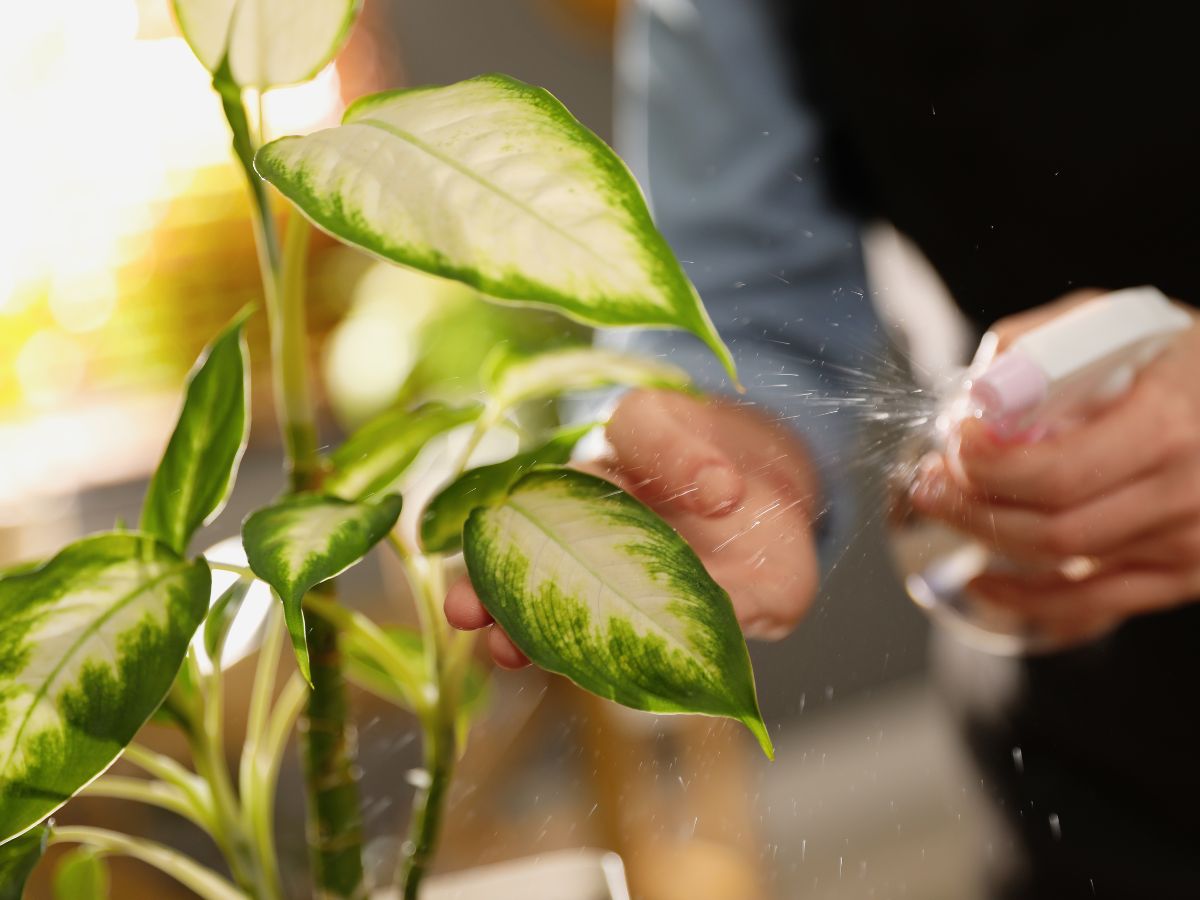
Overwatering is a common problem for Dieffenbachia plants and can lead to root rot, which can be fatal to the plant. Signs of overwatering include yellowing or browning of leaves, wilting, and a foul odor coming from the soil.
Preventative measures include using well-draining soil, avoiding overwatering, and ensuring good air circulation. If the plant has already been overwatered, treatment options include repotting the plant in fresh, well-draining soil, and allowing the soil to dry out between waterings.
Underwatering
Underwatering can also be a problem for Dieffenbachia plants, leading to stunted growth, wilting, and yellowing of leaves. Signs of underwatering include dry or crumbly soil, and leaves that feel brittle or papery.
Preventative measures include adjusting watering frequency and technique, ensuring good air circulation, and using a moisture meter to monitor soil moisture levels. Treatment options include watering the plant thoroughly and consistently, and adjusting the watering schedule as needed.
Other common problems
Other common problems for Dieffenbachia plants include yellowing or browning of leaves, wilting or drooping of leaves, and stunted growth. These problems can be caused by a variety of factors, including overfertilization, low light levels, and temperature extremes.
Solutions for these problems include adjusting the plant’s light exposure, water and soil management, and fertilization regimen. It may also be helpful to move the plant to a new location or adjust the temperature in the room to create a more suitable environment for the plant to thrive.
Toxicity and Safety
Overview of Dieffenbachia plant toxicity
Dieffenbachia plants are known for their toxicity to humans and pets. This toxicity is due to the presence of calcium oxalate crystals in the plant’s leaves and stem. When ingested or when sap comes in contact with the skin or mucous membranes, these crystals can cause severe irritation and swelling.
Symptoms of poisoning
Symptoms of Dieffenbachia poisoning can include burning and swelling of the mouth, tongue, and throat, difficulty swallowing, vomiting, and diarrhea. In severe cases, exposure to the plant can lead to respiratory distress or even death. The severity of symptoms can vary depending on the amount of exposure, the age and health of the person or animal, and other factors.
Safety precautions when handling Dieffenbachia plants

To minimize the risk of exposure to Dieffenbachia plant sap, it is important to wear gloves and long sleeves when handling the plant. Hands should be washed thoroughly after handling, and care should be taken to avoid rubbing eyes or other sensitive areas before washing. It is also important to keep the plant out of reach of pets and young children, who may be more susceptible to accidental exposure.
If accidental ingestion or exposure to Dieffenbachia plant sap occurs, seek medical attention immediately. Symptoms can be treated with medication, and in severe cases, hospitalization may be necessary.
Cultivation of non-toxic varieties
For those concerned about the toxicity of Dieffenbachia plants, there are several non-toxic varieties available. These varieties have been selectively bred to produce little or no calcium oxalate crystals, making them safer for homes with pets or young children. Popular non-toxic Dieffenbachia varieties include ‘Tropic Snow’, ‘Camille’, and ‘Starbright’.
While Dieffenbachia plants can be a beautiful and easy-to-care-for addition to any indoor garden, it is important to be aware of the potential risks associated with their toxicity. By taking appropriate safety precautions when handling the plant and considering non-toxic varieties, you can enjoy the beauty of Dieffenbachia plants without compromising the safety of your family or pets.
Frequently Asked Questions for Dieffenbachia Plants
Are Dieffenbachia plants easy to care for?
Yes, Dieffenbachia plants are generally considered easy to care for. They thrive in medium to bright indirect light and prefer to be kept consistently moist but not waterlogged.
What is the best soil mix for Dieffenbachia plants?
Dieffenbachia plants prefer well-draining soil that is rich in organic matter. A mix of peat moss, perlite, and vermiculite is a good choice for these plants.
Can Dieffenbachia plants be propagated?
Yes, Dieffenbachia plants can be propagated through stem cuttings. Simply take a cutting from the stem of the plant, dip it in rooting hormone, and place it in moist soil or water. The cutting should root in a few weeks and can be planted in a pot once it has established roots.
Are Dieffenbachia plants toxic to pets?
Yes, Dieffenbachia plants are toxic to pets, particularly cats and dogs. The calcium oxalate crystals in the plant can cause severe irritation and swelling if ingested or if sap comes in contact with the skin or mucous membranes.
How often should I fertilize my Dieffenbachia plant?
Dieffenbachia plants should be fertilized every 4-6 weeks during the growing season (spring and summer). Use a balanced liquid fertilizer diluted to half strength to avoid over-fertilization.
How often should I repot my Dieffenbachia plant?
Dieffenbachia plants should be repotted every 2-3 years, or when the roots begin to outgrow the pot. Choose a pot that is one size larger than the current pot and use fresh potting soil when repotting.
Can I prune my Dieffenbachia plant?
Yes, Dieffenbachia plants can be pruned to control their size or to remove damaged or diseased leaves. Use clean, sharp pruning shears and make cuts just above a leaf node.
Conclusion
In conclusion, Dieffenbachia plants are a popular and easy-to-care-for houseplant that can add beauty and a tropical feel to any indoor space. With their large, lush leaves and variety of colors and patterns, they make a statement in any room.
However, it is important to be aware of the potential risks associated with their toxicity and take appropriate safety precautions when handling the plant.
By following proper care and maintenance techniques, including providing adequate light and water, fertilizing regularly, and repotting when necessary, your Dieffenbachia plant can thrive and continue to bring joy to your home for years to come.


